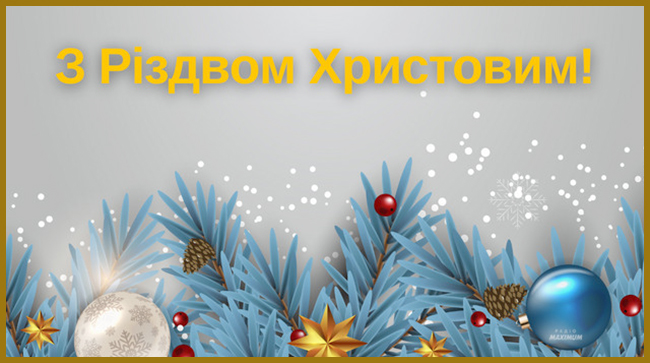Christmas. The history of the holiday’s origin
The Orthodox Church of Ukraine has granted permission to celebrate Christmas on December 25th according to the Julian calendar. The decision was adopted at the meeting of the Holy Synod of the OCU on February 2, 2023.
Christmas. The history of the holiday’s origin
Christmas has a long history. Millennia ago, the beliefs of Ukrainians were closely tied to natural phenomena, especially those influencing the harvest and, consequently, the well-being of the people. Celebrating the birth of the Sun was one of the most important holidays in ancient Slavic culture. This celebration was determined by various factors: the solstice, changes in nature, and the calendar, indicating the transition from darkness to light, from winter to spring.
Indeed, the most significant day was the winter solstice, marked by the shortest day and the longest night of the year. It was believed that during this period, the Sun embarks on its “triumphant” journey, bringing light and warmth once again. At this moment, a new phase begins, symbolizing the rebirth of nature.
Winter solstice – the celebration of the birth of the Sun
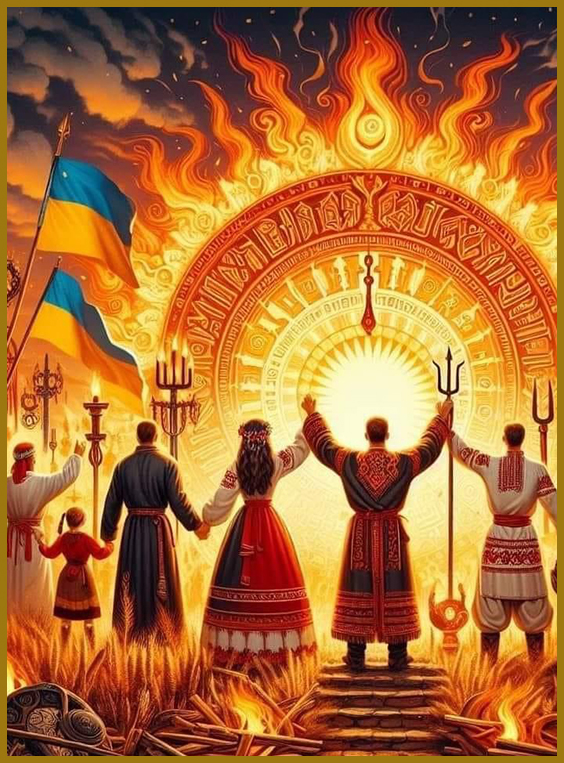
This year, the winter solstice occurred on December 22nd. It is a sacred celebration when the direction of the Sun’s movement shifts from descent to ascent. This mysterious phenomenon emerges somewhere at the border of existence in the form of an impulse that lifts the Sun upward once again.
The impulse itself is not yet visible, and the first glimpses of the spring sun have not appeared, but our ancestors already knew that this magical moment had arrived – the moment of the birth of the New Light! And the movement of this Sun cannot be stopped by anyone! Therefore, we congratulate you, friends, on the victory of Light over darkness and gloom!
One of the texts associated with the winter solstice is portions of the Rigveda – one of the oldest sacred texts in Hinduism, written in Sanskrit. The Rigveda includes hymns and prayers, some of which reflect rituals associated with natural phenomena. The Rigveda collection comprises Samhitas and mantras, which, like prayers, are used daily for various religious blessings.
We will provide you with a few lines from the Rigveda that underscore the significance of the winter solstice. This verse celebrates and highlights the role of the Sun in the natural order:
Let us contemplate the desired brilliance of the marvelous Luminary. May it illuminate our minds.
This mantra is dedicated to the reverence of Light and Wisdom, symbolizing spiritual education and wisdom. Because every person, throughout their life, must achieve the fruits of the four purusharthas – human goals in their spiritual development:
1.Dharma (Dharma): signifies righteousness. It is the life path in which you find yourself and are happy, where no one and nothing around you suffer from your actions. Dharma is the foundation for a just and harmonious life.
2. Artha (Artha): is considered an important aspect of human life, where you actualize yourself in this life and achieve prosperity (including material well-being).
3. Kama (Kama): when you are capable of enjoying all pleasures, including the satisfaction of emotional and sensory needs. It is important to note that the fulfillment of these desires is considered acceptable only within the bounds of Dharma.
4. Moksha (Moksha): when you have undergone all these trials and transcended the limits of the Universe. Moksha is liberation from the cycle of rebirths (samsara) and the attainment of spiritual freedom. It is the ultimate goal, the aspiration for union with the Divine and the attainment of the highest spiritual state. Moksha is typically achieved through self-realization, spiritual practice, and awareness of higher truths.
(The Source: uk.wikipedia.org)
The celebration of the birth of the Sun had a strong connection with the cult of nature and life cycles. It was a time of joy, community, and hope for a better future.
It was called by various names such as Kolyada, Yarilo, Dazhboh, and so on. For example, during the days of the Roman Empire, the day of the winter solstice was known as the Saturnalia, named after the celebration of the god Saturn – Dies Natalis Solis Invicti, ‘the Day of the Birth of the Unconquered Sun,’ as well as the birth of the sun god Mithras. The origins of these celebrations are clear: the Sun began to grow, and the day was getting longer. They included many rituals, songs, and ceremonies aimed at welcoming natural forces and invoking fertility.
Over time, Christian holidays such as Christmas became associated with these celebrations, reflecting events from the biblical story of the birth of Jesus Christ.
Yes, the solar cult’s influence is evident in songs dedicated to Christmas, where Jesus is referred to as the ‘True Sun,’ the ‘Sun of Righteousness’:
‘Rejoice, O Gracious Mother of God Virgin, for from you has dawned the Sun of Righteousness, Christ our God, enlightening those who are in darkness.’
Such wording is found in the Troparion of the Presentation of Our Lord, an important Christian holiday celebrated on the 40th day after Christ was born into our world by the Virgin Mary. It commemorates the day when Mary and Joseph brought the infant to the temple to offer thanks to God for the firstborn. The holiday is observed on February 2nd in the new style.
And from the Troparion of the Nativity of Christ, we read: ‘Your Nativity, O Christ our God, has shone to the world the Light of Wisdom… You are the Sun of Righteousness, O Lord, Glory to You!’
As we can see, modern New Year holidays coincide with ancient celebrations of the birth of the Sun and Christmas, as they are all united by the common theme of Light, renewal, and generosity, often highlighted in rituals and traditions accompanying this time of the year. Here are some more shared characteristics:
- Association with the Sun’s Turn:
All holidays include elements that mark the turning of the sun and the birth of Light. For example, Holy Evening or Koliada were traditional Slavic celebrations associated with the winter solstice, when the day becomes slightly longer after the longest night of the year. Such holidays served as an attempt to overcome darkness and celebrate the return of Light.
- Symbolism of Light:
In all cases, the symbolism of Light is crucial. Nowadays, candles, lanterns, and other sources of light can be used as symbols of hope, purity, and prosperity. In the past, fire rituals were conducted, where people lit huge bonfires, danced, sang songs, and wished each other prosperity and a happy New Year.
- Rituals and Ritual Songs:
Winter rituals and Christmas celebrations often share common features with a religious context. There are also ritual songs that frequently accompany these holidays.
- Family Traditions and Meals:
In all cases, it is a time of family bonding and shared moments. There are usually traditions related to food preparation and consumption, gift exchanges, and other customs that contribute to mutual understanding and harmony.
- Theme of Renewal and New Beginnings:
These holidays are also characterized by the theme of new beginnings and renewal. The winter solstice marks the transition from the darkest period to an increase in light, while Christmas symbolizes the birth of Jesus Christ, which, according to Christian tradition, heralds a new stage in human history.
Traditionally, all these celebrations are associated with the veneration of the Sun and its rebirth, leading to a convergence in the number of dishes in honor of these events. Specifically, the tradition of having 12 dishes during the Christmas Eve celebration and the Christmas dinner as a sacrificial feast in honor of Kolyada – the god of the winter solstice.
- General Symbolism of the Number 12:
The number 12 holds symbolism in various cultures and religions. In Christianity, for example, the number 12 is associated with the twelve apostles of Jesus Christ. Additionally, in the Book of Revelation, the final book of the New Testament depicting the apocalypse, the number 12 is mentioned in various contexts. In the Bible’s Old Testament, there is reference to the twelve tribes of Israel. The number 12 can signify completeness, symmetry, and unity.
- Solstices and Natural Cycles:
Considering that the winter solstice is a significant natural event associated with the change between light and darkness, the symbolism of the number 12 may reflect the division of the year into 12 months.
- Connection with the Solar Rite of Koliada:
Beliefs and rituals associated with Koliada are also linked to the veneration of the Sun and its rebirth, hence the possible convergence in the number of dishes in honor of these events.
In ancient times, the Christmas Eve dinner was a sacrificial feast in honor of Koliada – the god of the winter solstice. A sheaf of rye or wheat was placed in the corner, known as Didukh (the Moon)
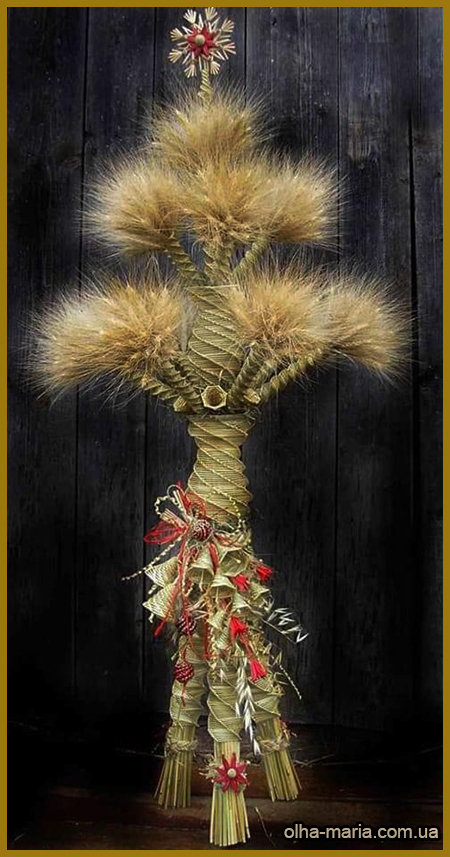
For the festive dinner, 12 logs were taken, representing offerings to the 12 constellations of the zodiac. Additionally, 12 ceremonial dishes were prepared, such as kutia with honey, uzvar, dumplings, cabbage rolls, fish, potatoes with mashed garlic, peas with oil and garlic, barley porridge with oil or honey, buckwheat porridge, boiled corn with poppy seeds, pies, and boiled beans.
On Christmas, it is customary to set 12 dishes on the festive table. Christians prepare for the holiday with a long fast. On Christmas Eve, the night before Christmas, devout people abstain from eating until the appearance of the first star in the sky, the one that guided the Magi to the Christ child.
On Christmas, one of the obligatory dishes is kutia — a dish made from boiled wheat mixed with poppy seeds, honey, walnuts, and raisins. It is a tradition to take kutia with you and go to visit godparents. Upon returning home, it can be shared with older relatives — grandmothers and grandfathers.
Sat down for the evening
The whole family, the entire kin,
And remembered in prayer
The name of God the Lord.
Let injustice perish,
Let sorrow and trouble vanish,
Rejoice, Christians,
The Christmas carol is coming.
Another interesting fact is that ancient New Year celebrations were divided into three periods: the birth of the Sun, the Moon, and Water. According to Christian tradition, these correspond to Christmas, Saint Basil’s Day, and Epiphany.
Good evening to you, dear master, rejoice!
Oh, rejoice, earth, the Son of God is born!
Spread the tables with all the carpets, rejoice!
Oh, rejoice, earth, the Son of God is born!
And place loaves of fresh wheat, rejoice!
Oh, rejoice, earth, the Son of God is born!
For three holidays will come to you as guests, rejoice!
Oh, rejoice, earth, the Son of God is born!
And the first holiday is Christmas,
Oh, rejoice, earth, the Son of God is born!
And the second holiday is Saint Basil’s Day, rejoice!
Oh, rejoice, earth, the Son of God is born!
And the third holiday is Epiphany, rejoice!
Oh, rejoice, earth, the Son of God is born!
Let our entire family celebrate with us, rejoice!
Oh, rejoice, earth, the Son of God is born!
Our entire family, glorious Ukraine, rejoice!
Oh, rejoice, earth, the Son of God is born!
Christmas carols
According to the beliefs of our ancestors, on Christmas night, the forces of chaos became active, and every impurity sought to hinder the maturation of the bright force. That’s why carolers wore masks so that evil forces wouldn’t recognize them. Carolers went from house to house, singing praising songs to Carol, driving away the dark impurity. These magical wardings and praises are called Christmas carols.
Caroler, caroling, caroler girl,
A pancake with honey is a treat,
And without honey, it’s not the same,
Give, dear sir, a five.
Open the little chest,
And give some cream,
Open the small chest,
And give a nickel.
Over time, Christmas carols took on a Christian tone, as this day is considered the birthday of Jesus Christ. In honor of the event of Christ’s birth, the Star shines, angels proclaim peace and happiness, and following them, carolers ask the King of Heaven to grant happiness and joy to all the hosts they visit.
During the Christmas days, there was a custom to go from house to house, praising with joyful songs the advent of the Savior into the world. Such song-singing was called caroling, and the singers themselves were called carolers. Children, in particular, were tireless carolers. At the forefront was the liveliest boy – the “star-bearer,” who carried the Christmas star, a traditional eight-pointed star with bells.
Silver bells rang under the windows, and people rejoiced. Everything that the little carolers wished for them on this festive day inevitably came true because those words were magical and came from the heart.
And with these words, the bells were ringing,
-In the bells we ring, and all bow down,
With happiness, health, and a long life,
And a long life, with good fortune,
For ourselves, and with our spouse,
And with all the children, and with Holy peace,
With the sacred deity, the Divine Christmas!
In every house, generous gifts awaited the young carolers, and soon they had a sack full of presents. In such groups, there was a treasurer who carried all these gifts.
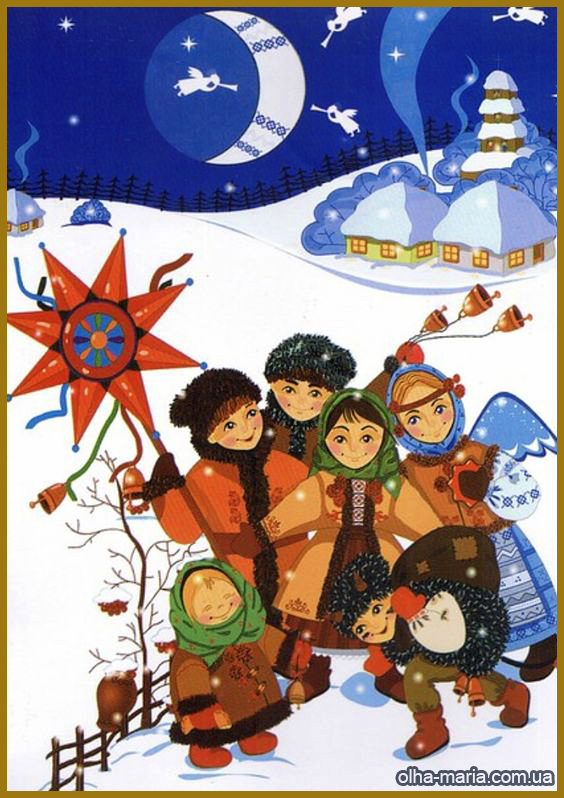
Carolers began to sing carols after the rise of the first star. Entering the homes, they would call out:
– Master, allow us to praise and sing about Christ!
– Please do, – the hosts would respond.
The carolers sang Christmas songs:
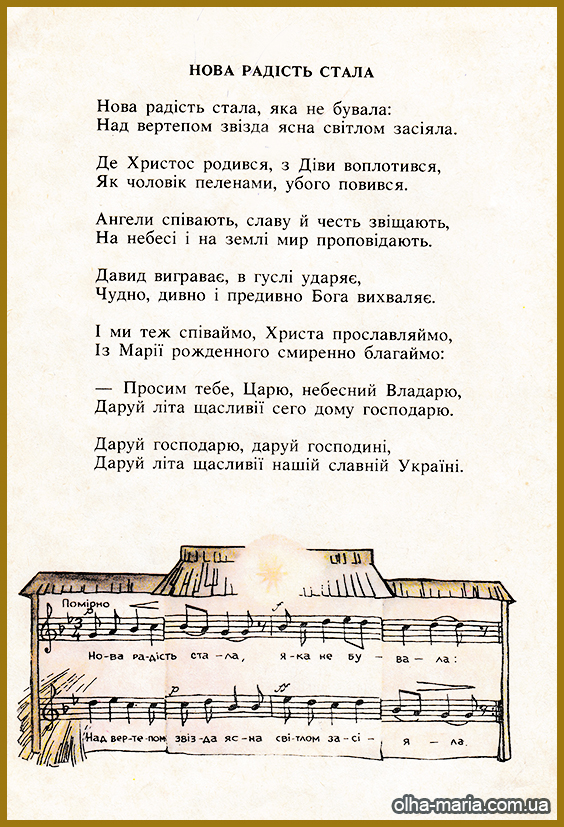
Nova Radist Stala (New Joy Has Come)
New joy has come, a joy that never was:
Above the nativity scene, a bright star has shone.
Where Christ was born, incarnate of the Virgin,
As a man, wrapped in swaddling clothes, He humbly lies.
Angels sing, proclaiming glory and honor,
In heaven and on earth, they announce peace.
David plays, striking the harp,
Wonderfully, miraculously, and marvelously praising God.
And we too shall sing, glorifying Christ,
Born of Mary, let us humbly entreat:
We ask You, King, Heavenly Ruler,
Grant happy years to this household.
Grant to the master, grant to the mistress,
Grant happy years to our glorious Ukraine.
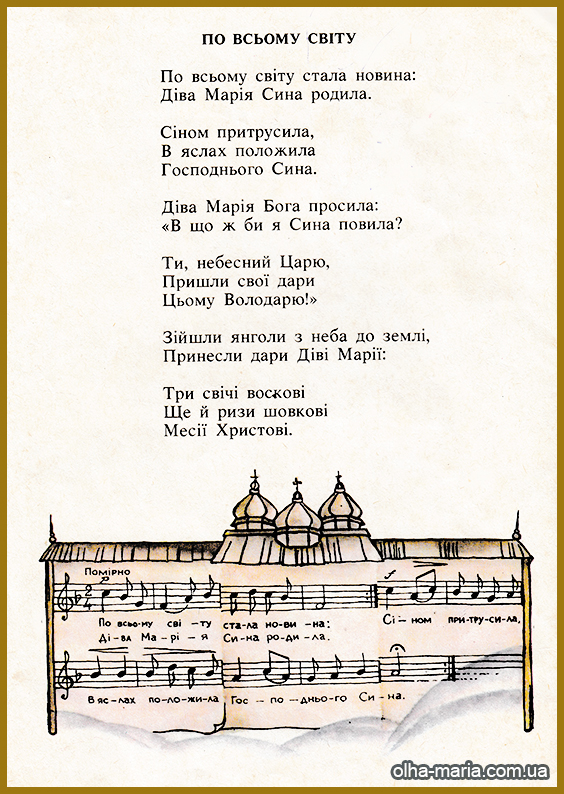
Throughout the World
Throughout the world, the news has spread:
The Virgin Mary has given birth to a Son.
She sprinkled the hay,
Laid Him in the manger,
The Son of the Lord.
The Virgin Mary implored God:
“How should I swaddle the Son?”
You, Heavenly King,
Send your gifts
To this sovereign!”
Angels descended from heaven to earth,
Bringing gifts to the Virgin Mary:
Three wax candles
And silk garments
For the Messiah, Christ.
So It Goes in Ukraine
So it goes in Ukraine,
Long ago, Christ’s praise began.
For on the Christmas starry night,
A simple truth shines upon us:
“Jesus is born! Let us glorify
His Holy birth!
Let us learn from the Son of God
To love our neighbors as ourselves.”
The star rises over Bethlehem,
The Christmas Carol flows.
The world rejoices, and within it, we,
Ukraine, the young.
“Bless us to sing carols!”
Resounds in villages and towns.
In homes, the Mother of God enters
With the Child in her arms…
(Lesya Stepovychka)
Excerpt from Mykola Tsybenko’s Work “Sergiyko’s Christmas”
“…The next day, on Christmas Day, Sergiyko spent almost the entire day caroling—again to godparents, and neighbors, and relatives. He and his father had prepared for Christmas in advance, and he had learned a less-known carol, a carol his grandfather had taught his father. The boy caroled like this:
And in the master’s house and in his yard,
Let paradise unfold!
Christ is born
In this home.
And the Mother of God gave birth to a Son,
Let paradise unfold!
Christ is born
In this home.
Oh, Holy Christmas brought joy,
Let paradise unfold!
Christ is born
In this home.
Grant, O God, to reap the new harvest,
Let paradise unfold!
Christ is born
In this home!
Usually, all the children sang the simplest and well-known carol:
Kolyad-kolyad-kolyadnitsa,
Good with honey pancake…
It’s understandable that such carolers were given ordinary treats, while Serhiyko was gifted more generously, so he caroled with a full bag of treats. He could barely make it home with such a load…”
Christmas (Birth of Jesus Christ)
Christmas is the favorite holiday of all children, isn’t it?
Birth is always an important and joyful event in people’s lives when relatives congratulate happy parents, give gifts, and wish health and prosperity to the newborn. After all, you also love your birthday, which you celebrate every year, don’t you?
Christmas has become the most significant event for all of humanity. Moreover, the modern calendar is also based on the birth of Christ. Yes, in the current year, you can determine how many years ago the Savior of the world was born. However, the mention of Christmas first appears only in the third century. How is this “amnesia” of people explained? Why did the date of His birth fall into complete “oblivion”? Although in the Bible, for example, there are many other precise datings.
To answer this question, one must look at the historical and cultural context in which Jesus was born and lived. However, during that time, Jews simply did not celebrate their birthdays. For example, in the Bible, there are only three mentions of celebrating a birthday. Could it be that the Jews were so indifferent to their children that they didn’t even celebrate their birthdays? Quite the opposite. The paradox lies in the fact that the Jews were one of those ancient peoples who treated the birth of children with the utmost care and special excitement. When a baby was born into a family, it was not just the event of birth that was celebrated, but the rituals that took place over the first 40 days of the child’s life.
However, in the religious consciousness of that time, people held the belief in the inherent sinfulness of humanity. If people are born with something that would later cause them to suffer and sin, why celebrate the day that marked the beginning of all these sorrows and sufferings? This explains the absence of an exact date of Jesus Christ’s birth in the Holy Scriptures.
Thus, for the Christians of the first two centuries, the fact of Christ’s birth was sufficient. However, in the early 3rd century, Christian writer Clement of Alexandria mentioned that he knew people who were diligently trying to determine not only the year but also the day of Jesus Christ’s birth. Later, in the 4th century (according to various sources, either in 336 or 353), Christmas began to be celebrated on December 25th in the Roman Church, while Epiphany was set on January 6th.
This occurred after the Roman Emperor Constantine the Great ceased the persecution of Christianity in the early 4th century. Only after this, the Church was able to establish the celebration of Christmas. Christians believed that on that day, the creator of the Sun was born because the human became the Creator. The God-man – the Absolute – was born.
The infant born to Mary is the same God! But why did God become human? St. Irenaeus of Lyons answered this question as follows:
“God became human so that humanity could become divine.”
The Apostle Paul calls this “self-abasement.” Because for a person to ascend to Heaven, Heaven had to descend to Earth. Such is the philosophy; think about it…
The miracle of Christmas lies in the fact that Jesus appeared in the world precisely on the day of the winter solstice. For a person to become God, humanity was given the opportunity to change. So why not celebrate Christmas along with the winter solstice? After all, the Gospel doesn’t say a word about the date of Christmas; it only says that Christ was born. This is where the striking freedom of choice given to humans by God lies—to accept or not to accept these facts.
Indeed, the birth of Jesus Christ was strange and incomprehensible to human understanding. He, who is so High and Holy, is born of a Virgin and descends to sinful Earth. He is born not in a luxurious royal palace but in a cave on the outskirts of the city. He is born in poverty and humility; His mother even had to place the newborn in a manger—a trough for livestock feed. Heavenly Angels at that moment praised Him not with noble figures but with simple, poor shepherds.
All of this is celebrated in the wonderful Christmas carol:
And above the nativity scene, a little star is shining bright,
Christ is born, proclaiming to all with delight.
Angels from heaven swiftly descend,
Singing glory to Him, their voices blend.
When the shepherds heard in the open field,
They hurried to the nativity, their hearts revealed.
There, in the manger, the Child lay,
His face, like the sun, radiating a gentle ray.
His mother, a wondrous lily fair,
The pure and glorious Virgin Mary, rare.
The shepherds bowed before the infant divine,
On their knees, in humble reverence, they incline.
Somewhere far, in the vast azure space,
Angelic choirs celebrate the Child’s grace.
We can learn about the events that led to the important Christian holiday of Christmas, as described in the Gospel of Matthew and Luke. When the Virgin Mary and Joseph set out for Bethlehem at the decree of King Herod, who deemed it necessary to conduct a census at that time, they found no lodging in the city. Therefore, Mary and Joseph took refuge in a cave, where a stable was arranged. It was there that Jesus Christ was born, later known as the Messiah and Savior of humanity. On that day, the Star of Bethlehem appeared in the sky, and the shepherds were the first to learn about the birth of the Son of God because Angels told them.
“And there were in the same country shepherds abiding in the field, keeping watch over their flock by night. And, lo, the angel of the Lord came upon them, and the glory of the Lord shone round about them: and they were sore afraid.”
(Luke 2:8-9)
And the Angel said to them, “Fear not, for behold, I bring you good tidings of great joy, which shall be to all people. For unto you is born this day in the city of David a Savior, who is Christ the Lord. And this shall be a sign unto you: Ye shall find the Babe wrapped in swaddling clothes, lying in a manger.” And suddenly there was with the Angel a multitude of the heavenly host praising God and saying:
“Glory to God in the highest, and on earth peace, goodwill toward men!”
(Luke 2:10-14)

We all know that there are many icons dedicated to this holiday. Iconography can vary, but the central image always depicts the Infant lying in the manger, with the Most Holy Virgin (Mother of God) and Joseph nearby. Joseph learned that Mary, who did not know a man, would have a child. According to ancient Jewish tradition, a woman was stoned to death for adultery. However, the righteous Joseph chose to be merciful. His heart was open to the revelation that Mary would give birth by the Holy Spirit, and he couldn’t let her go. Joseph had to care for the Mother of God and her divine Infant.
In our time, during the Christmas celebration in the Cathedral of Christ the Savior, a service to Jesus Christ, our Savior, is always held.
Why is the Christmas tree decorated for Christmas?
Long ago, in pagan times, trees were revered as deities. People tried to decorate them by hanging various objects and lighting fires on them. So, the tradition of decorating trees is very ancient. The Germans were the first to adopt it for the Christmas holiday. But why did they start decorating the fir tree specifically? Probably because in winter, there is no more beautiful tree than the evergreen fir tree.
Later, this tradition became widespread. It resonated with many people because it reminded them of the earlier custom of decorating willow branches on Palm Sunday.
Christmas Greetings
With the celebration of Christmas comes the long-awaited time of rest and joy – the Holy Days, which last until the Feast of the Baptism of the Lord. It was previously considered a great sin to forget about orphans, the elderly, the poor, and the sick during these days. It is the duty of people during these Holy Days to provide assistance to all those in need.
Grant us, Jesus, both happiness and fortune,
Give us the strength to do good!
To overcome misfortune, defend freedom,
Rejecting injustice and evil!
May the Christmas star shine upon us
From the manger throughout all Ukraine!
And, strong with truth, in family unity,
Let us glorify the heavenly King!
MERRY CHRISTMAS, our dear readers! We wish that in Ukraine, always under the glow of the Christmas Star, the Holidays will be cheerful and generous!
Happy New Year to all of us!!!
Thank you for being with us! Share your thoughts on what you’ve read in the comments.
Don’t forget to subscribe to our channels:
Or click on the link to go to the HOME PAGE
This article was prepared for you by Zinoviyeva N. P. and Olga-Maria.
References:
- What holiday do we have today, mom? Religious edition for younger and middle school age – Kramatorsk: 2000, 119 p.: ill.
- The world around us and inside us. Teacher’s manual for grade 2 – M .: “Fundamentals of Orthodox Culture”, 2006.
- Zh.: Loza (Orthodox magazine for those who can think), December 2011.
- Sow, be born: Christmas carols, Shchedrivkas, spring songs – K .: School, 2006. – 176 p.: ill. – (Reader for schoolchildren)
- Kovalchuk O. V. Ukrainian ethnology. Book for the teacher. – K .: Education, 1994 – 176 p.
- Oh, rejoice, earth! Christmas carols and Shchedrivkas – K .: Veselka, 1990. – 15 p.: ill.
- Christmas carols. Shchedrivkas. For younger school age. – Kharkiv: Maket, 2003. – 10.
